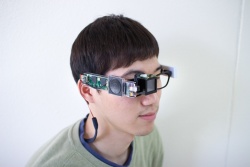Difference between revisions of "K-Glass"
(summary) |
m (→Main characteristics: fixed typo) |
||
| Line 37: | Line 37: | ||
== Main characteristics == | == Main characteristics == | ||
| − | The device consists of one 800x600 pixels micro-display, 720p camera, touchpad, and auxiliary hardware. K-Glass uses novel way of image recognition. The on-board augmented reality processor BONE-AR utilizes data processing network to analyse the scene and allows the device to react with relevant virtual information quickly. This custom processor is based on the Visual Attention Model that mimics how natural human vision works, without the need to use any | + | The device consists of one 800x600 pixels micro-display, 720p camera, touchpad, and auxiliary hardware. K-Glass uses novel way of image recognition. The on-board augmented reality processor BONE-AR utilizes data processing network to analyse the scene and allows the device to react with relevant virtual information quickly. This custom processor is based on the Visual Attention Model that mimics how natural human vision works, without the need to use any markers.<ref name="physorg14">http://phys.org/news/2014-02-low-powered-high-speed-head-mounted-augment-reality.html</ref> In comparison to similar HMD systems, K-Glass recognizes items in the scene quicker and uses less power.<ref name="kglass15" /> |
KAIS also developed a newer version called K-Glass 2.<ref>http://phys.org/news/2015-03-kaist-ui-k-glass-eye.html</ref> This iteration is equipped with gaze recognition interface called i-Mouse. It enables the user to use gaze and winking as a form of input. | KAIS also developed a newer version called K-Glass 2.<ref>http://phys.org/news/2015-03-kaist-ui-k-glass-eye.html</ref> This iteration is equipped with gaze recognition interface called i-Mouse. It enables the user to use gaze and winking as a form of input. | ||
| Line 46: | Line 46: | ||
=== Company & People === | === Company & People === | ||
<!-- This is a list of important people behind the technology. Note: It is not necessary to list absolutely everyone. --> | <!-- This is a list of important people behind the technology. Note: It is not necessary to list absolutely everyone. --> | ||
| − | + | ||
== Important Dates == | == Important Dates == | ||
<!-- A list of important dates in the development and history of the technology. Use the information provided in the second half of the Main characteristics section and make it into a short, unnumbered list. --> | <!-- A list of important dates in the development and history of the technology. Use the information provided in the second half of the Main characteristics section and make it into a short, unnumbered list. --> | ||
Revision as of 11:40, 15 December 2015
| K-Glass | |
|---|---|

|
|
| Category | smartglasses |
| Developer | Korea Advanced Institute of Science and Technology [1] |
| Announced | 17 February 2014 [2] |
| Released | Developers: 2014
Consumers: 2015 [3] |
| Price | USD (unknown) |
| Operating system | Android [4] |
| Display | LCD [4] |
| Resolution | 800x600 pixels [4] |
| Field of view | (unknown) |
| Weight | g (unknown) |
| Controls | |
| Data available | good |
| Risk factor | low |
| Standalone | |
| http://ssl.kaist.ac.kr/ | |
K-Glass is a head-mounted, augmented reality system being developed by Korea Advanced Institute of Science and Technology (KAIST). It uses novelty image recognition hardware and software to quickly analyse the scene through the incorporated camera and displays relevant information to the user.
The device has not yet entered commercial market. Professor Yoo Hoi-jun[6], one of the authors of the paper introducing the device, said that they planned to commercialize the device by the beginning of 2015.[3] As of December 2015, no new information is known about K-Glass, nor is the device available to purchase.
Contents
Main characteristics
The device consists of one 800x600 pixels micro-display, 720p camera, touchpad, and auxiliary hardware. K-Glass uses novel way of image recognition. The on-board augmented reality processor BONE-AR utilizes data processing network to analyse the scene and allows the device to react with relevant virtual information quickly. This custom processor is based on the Visual Attention Model that mimics how natural human vision works, without the need to use any markers.[7] In comparison to similar HMD systems, K-Glass recognizes items in the scene quicker and uses less power.[4]
KAIS also developed a newer version called K-Glass 2.[8] This iteration is equipped with gaze recognition interface called i-Mouse. It enables the user to use gaze and winking as a form of input.
Purpose
Company & People
Important Dates
Enhancement/Therapy/Treatment
Ethical & Health Issues
Public & Media Impact and Presentation
Public Policy
Related Technologies, Projects or Scientific Research
International Solid-State Circuits Conference (ISSCC), February 9-13, 2014, San Francisco[9]
Links
https://www.youtube.com/watch?v=fzQpSORKYr
http://phys.org/news/2015-03-kaist-ui-k-glass-eye.html
http://phys.org/news/2014-02-low-powered-high-speed-head-mounted-augment-reality.html
http://www.itweb.co.za/index.php?option=com_content&view=article&id=142116
http://www.koreaherald.com/view.php?ud=20140702000859
http://www.gizmag.com/k-glass-smart-glass/30904/
http://www.sciencedaily.com/releases/2014/02/140217084420.htm
References
- ↑ Korea Advanced Institute of Science and Technology [online]. Available online at: http://www.kaist.edu/html/en/ (Retrieved 15 December)
- ↑ KAIST developed an extremely low-powered, high-performance head-mounted display embedding an augmented reality chip. Research: asia research news [online]. 2014, 17 February. Available online at: http://www.researchsea.com/html/article.php/aid/8078/cid/1/research/science/researchsea/kaist_developed_an_extremely_low-powered__high-performance_head-mounted_display_embedding_an_augmented_reality_chip.html (Retrieved 15 December 2015)
- ↑ 3.0 3.1 JI-HYE, Shin. K-Glass to be unveiled in 2015. The Korea Herald [online]. 2014, 2 July. Available online from: http://www.koreaherald.com/view.php?ud=20140702000859 (Retrieved 15 December 2015)
- ↑ 4.0 4.1 4.2 4.3 4.4 KIM, Gyeonghoon; CHOI, Sungpill; YOO, Hoi-Jun. K-glass: Real-time markerless augmented reality smart glasses platform. In: Industrial Technology (ICIT), 2015 IEEE International Conference on. IEEE, 2015. p. 1712-1717.
- ↑ RAWLINS, Lauren Kate. Smart glasses that work with a wink. ITWeb Limited [online]. Johannesburg, 2015, 24 March. Dostupné z: http://www.itweb.co.za/index.php?option=com_content (Retrieved 15 December)
- ↑ http://ssl.kaist.ac.kr/2007/sub3_1.php
- ↑ http://phys.org/news/2014-02-low-powered-high-speed-head-mounted-augment-reality.html
- ↑ http://phys.org/news/2015-03-kaist-ui-k-glass-eye.html
- ↑ KIM, Gyeonghoon, et al. A 1.22 TOPS and 1.52 mW/MHz Augmented Reality Multicore Processor With Neural Network NoC for HMD Applications. Solid-State Circuits, IEEE Journal of, 2015, 50.1: 113-124.